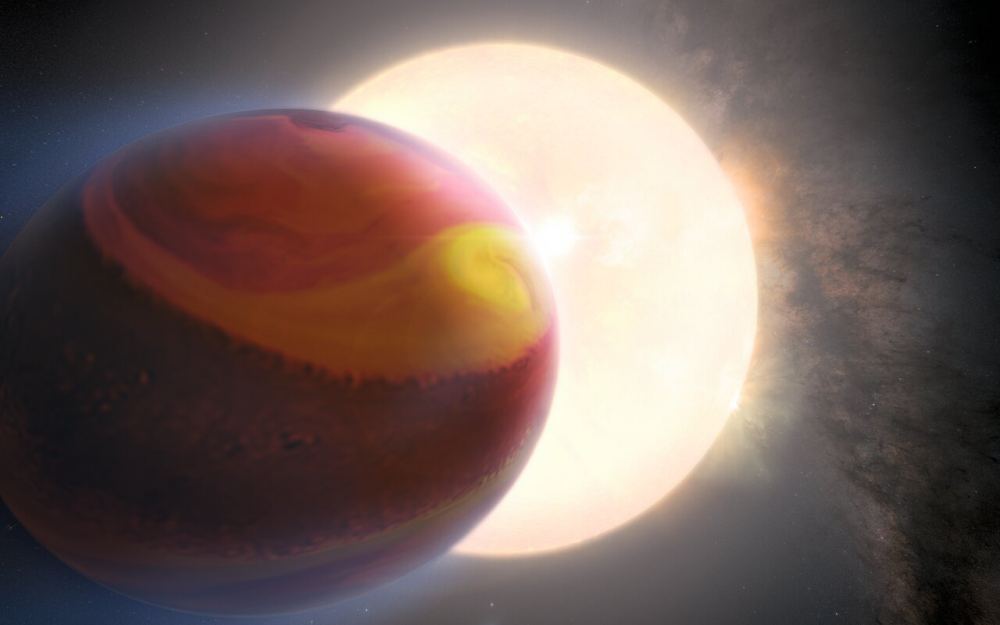If you want to know more about an exoplanet atmosphere, watch how it changes over time. That’s the mantra of a group of astronomers who just reported on conditions at Tylos, otherwise known as WASP-121 b.
Tylos is a hot Jupiter world. It lies in a tidally locked 30-hour orbit around WASP-121. That means the planet shows the same face toward its star. As a result, one hemisphere is heated to over 3000 K. Such “overheating” affects the weather on Tylos and creates a hotspot on the star-facing side. That high temperature atmosphere makes for some intriguing chemicals there.
Astronomers wanted to track the heat-driven atmospheric changes, according to Quentin Changeat, principal investigator of a team that used three years’ worth of Hubble data to study Tylos. “Studying exoplanets’ weather is vital to understanding the complexity of exoplanet atmospheres, especially in our search for exoplanets with habitable conditions,” he noted, and compared it to studying Earth’s weather. “Weather on Earth is responsible for many aspects of our life, and in fact, the long-term stability of Earth’s climate and its weather is likely the reason why life could emerge in the first place.”
Hubble’s Exoplanet Atmosphere Advantage
The venerable Hubble Space Telescope continues to amass a pretty remarkable archive of exoplanet observations, including peeks at their atmospheres. That allows astronomers to look at how those worlds and their atmospheres change over time. Hubble has observed Tylos several times, and the datasets give a unique look at how its atmosphere behaves.
Changeat’s team combined four sets of archival observations of Tylos made using Hubble’s Wide Field Camera 3 (WFC 3). The combined data set includes a look at the planet transiting in front of its star in June 2016). There’s also a peek at it transiting behind its star in November 2016). Two phase curves measure the amount of light detected from the planet and its star during an orbit. They were taken in March 2018 and February 2019. The team carefully processed the data, which was a lengthy process.
“Our dataset represents a significant amount of observing time for a single planet and is currently the only consistent set of such repeated observations,” explained Changeat. “The information that we extracted from those observations was used to characterize (infer the chemistry, temperature, and clouds) of the atmosphere of WASP-121 b at different times. This provided us with an exquisite picture of the planet, changing in time.”
About Tylos’s Atmosphere
As the team worked with the datasets, they found that the planet’s hotspot was shifting. In addition, the spectral fingerprint of chemicals indicated that something about the planetary atmosphere was changing. That led the team to create computer models to explain the changes they were seeing. The best explanation so far is that there are quasi-periodic weather patterns at Tylos. They resemble massive cyclones. Over time, they arise, rage across the upper atmosphere, and then dissipate. The huge temperature differences between the hotter and cooler regions likely play a role in these patterns.
In addition, the behavior of the hot spot on Tylos is especially intriguing. Such hot spots are pretty common. They don’t always stay in the same place but instead seem to migrate slightly through the atmosphere. Astronomers see that “offset” position in many exoplanets. The best explanation for that apparent shift could be the presence of upper atmospheric winds or some other disturbance that affects the stability of a hotspot.
Seeing shifts in a hotspot and changes in weather patterns on a world 880 light-years away is a big accomplishment and marks a big step forward in exoplanet observations. “The high resolution of our exoplanet atmosphere simulations allows us to accurately model the weather on ultra-hot planets like WASP-121 b,” explained Jack Skinner, a postdoctoral fellow at the California Institute of Technology and co-leader of the project. “Here we make a significant step forward by combining observational constraints with atmosphere simulations to understand the time-varying weather on these planets.”
Future Work
Observing exoplanets and their atmospheres isn’t a “one shot and you’re done” kind of activity. Light from the star moves through the atmosphere. As it passes through, specific chemicals absorb various wavelengths of light. A spectral study of that light shows “dropouts” where the absorptions happen and those dropouts tell scientists what chemicals exist there. It can also indicate changes in the atmospheric chemistry over time.

As this study indicates, “temporal resolution” (i.e. many observations over a longer period) gives astronomers more chances to understand how these worlds change. The additional data are added to models that explain atmospheric evolution. We’ve learned that in studies of our gas giants, for example. Neptune and Uranus showed tantalizing storms in the snapshots taken by the Voyager 2 spacecraft decades ago. Follow-up observations over longer periods from Hubble and the Keck II telescopes (for example), allow planetary scientists to track storms and other atmospheric disturbances. The same is true for studies of Mars and its surface markings. Temporal resolution is a valuable tool.
So, applying the same approach to distant exoplanets will, in the long run, give us insights into changes in their atmospheres. And, it will eventually show us which ones may have life onboard, simply from the evidence of certain chemicals in their blankets of air. Long-term observations by Hubble and, of course, the JWST, will give more evidence of weather patterns on distant worlds. Eventually, they’ll turn up those worlds that can support life, and their atmospheric studies may well tell us what that life is like, how long it’s been there, and what effect it has on its home world.
For More Information
Hubble Observes a Changing Exoplanet Atmosphere
Is the Atmosphere of the Ultra-hot Jupiter WASP-121b Variable?

